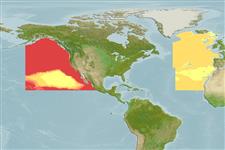Environment: milieu / climate zone / depth range / distribution range
Οικολογία
Θαλασσινό(ά) βαθυπελαγικό(ς); εύρος βάθους 400 - 1620 m (Ref. 50610). Deep-water; 66°N - 18°N, 160°W - 5°W
Eastern Atlantic: Madeira Islands. Eastern Pacific: British Columbia, Canada (Ref. 11980). Some records of Maulisia argipalla have been misidentified as Maulisia mauli.
Μέγεθος / Βάρος / Age
Maturity: Lm ? range ? - ? cm
Max length : 19.5 cm SL αρσενικό/απροσδιόριστο; (Ref. 96339)
Meso- and benthopelagic at 850-1500 m (Ref. 58302).
Life cycle and mating behavior
Maturities | Αναπαραγωγή | Spawnings | Egg(s) | Fecundities | Προνύμφες
Quéro, J.-C., T. Matsui, R.H. Rosenblatt and Y.I. Sazonov, 1984. Searsiidae. p. 256-267. In P.J.P. Whitehead, M.-L. Bauchot, J.-C. Hureau, J. Nielsen and E. Tortonese (eds.) Fishes of the north-eastern Atlantic and the Mediterranean. UNESCO, Paris. Vol. 1. (Ref. 6682)
IUCN Red List Status (Ref. 130435)
Threat to humans
Harmless
Human uses
Εργαλεία
Special reports
Download XML
Διαδικτυακές πηγές
Estimates based on models
Preferred temperature (Ref.
123201): 3.4 - 7.5, mean 5.8 °C (based on 93 cells).
Phylogenetic diversity index (Ref.
82804): PD
50 = 0.5312 [Uniqueness, from 0.5 = low to 2.0 = high].
Bayesian length-weight: a=0.01122 (0.00514 - 0.02450), b=3.04 (2.87 - 3.21), in cm total length, based on all LWR estimates for this body shape (Ref.
93245).
Τροφικό Επίπεδο (Ref.
69278): 3.4 ±0.5 se; based on size and trophs of closest relatives
Ελαστικότητα (Ref.
120179): Μεσαίο(α), ελάχιστος χρόνος για διπλασιασμό πληθυσμού 1,4 - 4,4 έτη (Assuming tmax>3).
Fishing Vulnerability (Ref.
59153): Low vulnerability (14 of 100).
